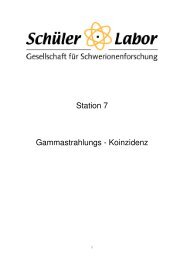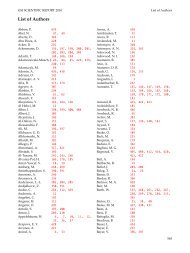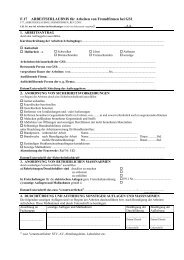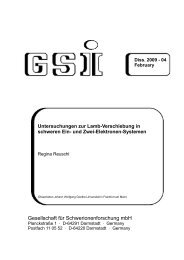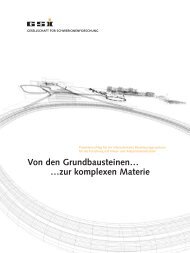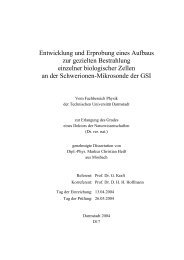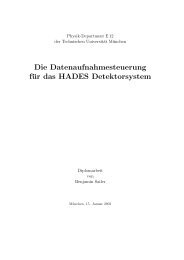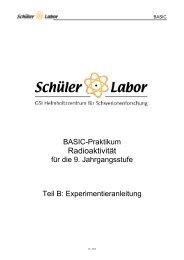CBM Progress Report 2006 - GSI
CBM Progress Report 2006 - GSI
CBM Progress Report 2006 - GSI
Create successful ePaper yourself
Turn your PDF publications into a flip-book with our unique Google optimized e-Paper software.
<strong>CBM</strong> <strong>Progress</strong> <strong>Report</strong> <strong>2006</strong> Simulations<br />
Fast simulation of low-mass electron pair measurements with <strong>CBM</strong><br />
Investigation of the invariant mass spectrum of short<br />
lived neutral vector mesons (ρ, ω, φ) via detection of their<br />
electron-positron pairs is one of the major issue of the <strong>CBM</strong><br />
physics. Besides of the electron-positron pairs that originate<br />
from the meson decays, there is a large number of<br />
electrons and positrons from π 0 -Dalitz decays and the γ<br />
conversions in the target and the detector material budged.<br />
In addition, the charged pions misidentified as electrons<br />
contribute to the background.<br />
Our study focus on Au+Au central reactions at 25 AGeV.<br />
The physics input was generated by the UrQMD event generator<br />
that accounts for the general event characteristics in<br />
terms of hadron production, and by PLUTO event generator<br />
that provides leptonic (e + e − pairs) and semi-leptonic<br />
decays of light vector mesons. The assumed multiplicities<br />
of mesonic “cocktail” together with the considered decay<br />
channels and their branching ratios can be found in [1].<br />
The <strong>CBM</strong> analysis framework with embedded GEANT3<br />
package [2] was used to transport primary particles through<br />
the <strong>CBM</strong> experimental set up geometry. The assumed STS<br />
geometry consists of enlarged first 6 STS stations to maximize<br />
the geometrical acceptance for low momentum particles.<br />
The magnetic field was set to 70% of its maximum<br />
value and the target thickness was set to 25µm. The reconstructed<br />
electrons are defined as these that passed through<br />
each of the 8 STS stations (tracking) and hit both RICH<br />
and TRD detector (high efficiency and purity of particle<br />
identification). The unlike sign pair invariant mass spectrum<br />
for the measured electrons is shown in Fig. 1 for uncorrelated<br />
(background, 10 5 events) and correlated (signal,<br />
16 × 10 6 events) components by the solid line and the solid<br />
dots, respectively. It is seen that except of low mass region<br />
(gamma conversion and π o -Dalitz) the combinatorial<br />
background exceeds signal by large factor that depends on<br />
invariant mass. In the range between 0.2 GeV and 0.6 GeV,<br />
specially interesting regarding the <strong>CBM</strong> physics, the signal<br />
]<br />
-1<br />
[(GeV)<br />
-<br />
e<br />
+<br />
e<br />
/dM<br />
-<br />
e<br />
+<br />
e<br />
dN<br />
×<br />
1/events<br />
10<br />
1<br />
-1<br />
10<br />
-2<br />
10<br />
-3<br />
10<br />
-4<br />
10<br />
-5<br />
10<br />
background pairs<br />
signal pairs<br />
0 0.2 0.4 0.6 0.8 1 1.2 1.4<br />
M + - [GeV]<br />
Figure 1: Combinatorial invariant mass spectrum for the<br />
measured electrons for uncorrelated pairs (background)<br />
and for correlated pairs (signal).<br />
P. Staszel, R. Karabowicz, Z. Majka<br />
e e<br />
Jagiellonian University, Poland<br />
17<br />
to background ratio is on the level of 3 × 10 −3 . In order<br />
to suppress the combinatorial background, the following<br />
cuts have been applied: (a) cut on the invariant mass<br />
(Minv < 16MeV ) of the partially reconstructed unlike<br />
sign pairs (partially means that one track forming the pair is<br />
not identified), (b) cut on the invariant mass of fully reconstructed<br />
unlike sign pairs (Minv < 55MeV ) and (c) cut on<br />
the particle transverse momentum (pT < 0.3GeV ).<br />
]<br />
-1<br />
[(GeV)<br />
-<br />
e<br />
+<br />
e<br />
/dM<br />
-<br />
e<br />
+<br />
e<br />
dN<br />
×<br />
1/events<br />
-1<br />
10<br />
-2<br />
10<br />
-3<br />
10<br />
-4<br />
10<br />
-5<br />
10<br />
combinatorial invariant mass<br />
background pairs<br />
signal pairs<br />
o ρ<br />
ω - Dalitz<br />
η - Dalitz<br />
0 0.2 0.4 0.6 0.8 1 1.2<br />
M + -<br />
e e [GeV]<br />
Figure 2: The combinatorial invariant mass spectrum of<br />
accepted tracks that survived all cuts. Realistic momentum<br />
resolution, track reconstruction efficiency and the pion<br />
suppression factor have been assumed.<br />
The analysis is based on the Monte Carlo tracks and does<br />
not take into account the realistic performance of the detection<br />
system as well as the reconstruction ability of the existing<br />
reconstruction software. To obtain the more realistic<br />
results we took the momentum resolution, track reconstruction<br />
efficiency and the pion suppression factor determined<br />
from data digitization and reconstruction <strong>CBM</strong> procedures<br />
[3, 4]. The combinatorial invariant mass spectrum of accepted<br />
tracks that survived all cuts, together with the signal<br />
and background components are plotted in Fig. 2 as black<br />
symbols, red symbols and by the solid line, respectively.<br />
The obtained result is very promising showing that the<br />
concept of the <strong>CBM</strong> detector geometry is well suited for<br />
the di-electron measurement in the low mass regime. This<br />
analysis, however, does not include realistic particle identification<br />
efficiency. This effect will be considered in the<br />
forthcoming studies.<br />
References<br />
[1] T. Galatyuk and J. Stroth, <strong>CBM</strong>-PHYS-note-<strong>2006</strong>-001.<br />
[2] M. Al-Turany et al., FairRoot/CbmRoot Simulation and<br />
Analysis Framework, this report.<br />
[3] C. Höhne et al., Electron identification with RICH and TRD<br />
in <strong>CBM</strong>, this report.<br />
[4] T. Galatyuk et al., Full reconstruction of low-mass electron<br />
pairs in <strong>CBM</strong>, this report.



